Review of the Rostock septic tank: device, model range, advantages and disadvantages
Modern city dwellers increasingly prefer to spend time at their dachas during the hot summer months.But this does not mean that people are trying to give up all their city habits: a warm toilet, cold and hot water should be in the house. Do you agree?
For those who are planning to install an autonomous sewer system, the Rostock septic tank will be of interest, a review of which we offer you. We'll show you in detail how to choose the model that's perfect for your needs. The article we have proposed also discusses the installation rules in detail.
The content of the article:
Design and principle of operation
The problem of autonomous heating and water supply was solved by summer residents long before they became interested in the possibility of installing a local sewerage system on their site.
The solution to the latter problem is responsible for the appearance of septic tanks on sale. These devices allow you to clean domestic wastewater and are a key element of local sewage systems. "Rostock" is one of the most popular septic tank models.
Like most similar devices, the “Rostock” is designed quite simply. Essentially, this is a single tank divided into two chambers. One of the cameras is equipped with special filters. To better understand the structure of this septic tank, let’s understand the principle of its operation.
Initially, all wastewater through sewer pipes ends up in the first chamber. This happens by gravity. The inlet pipe through which wastewater enters the septic tank is equipped with an absorber. It prevents sediment accumulated at the bottom of the chamber from being agitated.
The first chamber is a settling tank. In it, all wastewater is divided into fractions. Heavy fractions settle to the bottom of the chamber: they will subsequently be pumped out. Light fractions rise upward along with liquid waste. Effluents devoid of heavy fractions are considered clarified.
So, the clarified wastewater, moving from bottom to top, enters the next chamber. It, as we already mentioned, is equipped with filters. A mesh filter is used to retain large contaminants. The second filter is sorption. It is made of a special material – zeolite, the thickness of which reaches 20 cm.
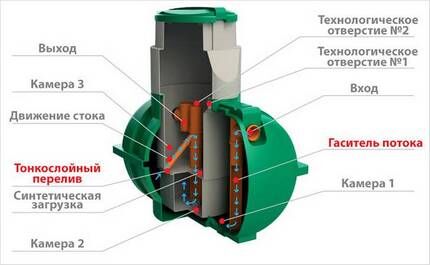
When the wastewater passes through both filters, it is cleaned by 70-80%. Now they can be removed from the septic tank for further treatment. This procedure is performed using multi-layer soil backfill or special biofilters.
Will familiarize you with the general principles of the design and operation of septic tanks next article. The video located in the final block of our article will help you visually imagine the work of the Rostock country septic tank.
Operation and care of the device
The key element of the Rostock local treatment plant is easy to operate. Solid fractions accumulated in the first chamber must be removed periodically. This is usually done once a year, provided the device is used year-round.
If operation is limited to the summer period, then the first chamber is cleaned every two years. To solve this problem, a sewage disposal machine should be used.
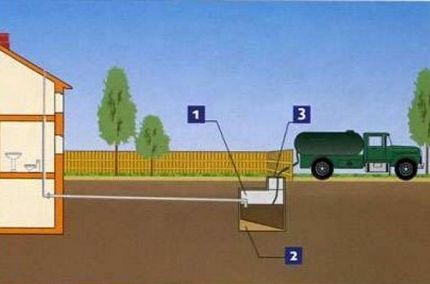
The sorption filter located in the second chamber is also reactivated approximately once a year. The zeolite layer is simply washed with a solution of ordinary table salt. Filters need to be changed at least once every 15 years.
To increase the efficiency of wastewater treatment, you can use special biological products. With their help, the anaerobic processes occurring in this device become more intense. Colonies of bacteria contained in additives process organic matter in wastewater, resulting in an increased degree of purification.
Comparison of advantages and disadvantages
When choosing a septic tank, we, of course, are interested in its advantages, not forgetting to ask about the disadvantages. After all, before buying, you definitely need to weigh both: the decision depends on what outweighs in each individual case. Therefore, we will talk about both the pros and cons of the Rostock treatment plant.
Let us list the obvious advantages of the device.
- Strength and durability. The body of the product is made using the one-piece method: the chambers are not separated from one another. If you take into account the presence of stiffeners, you can be sure that this structure will be durable and will last a long time.
- Unpretentiousness to operating conditions. For the Rostok septic tank to work, it does not need to be connected to power. It turns out that it can be used in areas where there is no need to talk about developed infrastructure yet.
- Quality of work. This device provides a high degree of wastewater purification. When biologically active drugs are added to Rostok, we can safely say that the wastewater will be purified up to 92%. Oils and fat do not enter the second chamber of the container at all.
- Easy to install. The device does not require special skills during the installation process and in bringing the septic tank to working condition. For this purpose, it is not at all necessary to involve professionals: you can handle it yourself.
- Reliability and security. The inlet pipe of the device is equipped with a damper, thanks to which even a sudden discharge of a significant volume of water into the sewer will not lead to water hammer.
The installation pleases with its thoroughly thought-out design.The device's pipes (inlet and outlet) are attached to the body using flexible elements, which allows them to remain unharmed even if the tank itself moves during seasonal ground movements.
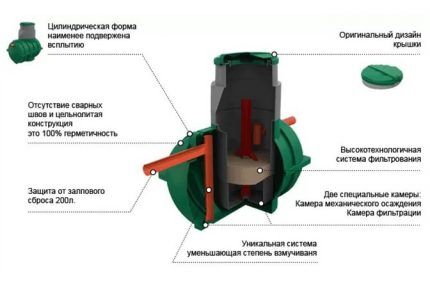
This device also has disadvantages:
- Light weight. The low weight of the device is a significant advantage in the process of its installation, which can also become a disadvantage if we consider the risk of it “floating” from the ground during periods of seasonal rise of groundwater. Although the shape of the Rostock does not facilitate this process, it is better to consider the possibility of installing a concrete base to secure it.
- Site occupancy. The dimensions of the Rostok dacha septic tank suggest that it will occupy about 4 m2 of site area. This area cannot be planted with anything other than grass and small shrubs. In this area, with the addition of a meter along its perimeter, it is impossible to equip parking for vehicles, since the septic tank can be accidentally pushed through.
- Waste disposal costs. Unfiltered waste must be pumped out using vacuum trucks. This means that your budget should include this expense item.
- Device location. “Sprout” cannot be located wherever you please. It is imperative to take into account sanitary standards and the fact that a sewage disposal truck must drive up to it. This means it must be close to the road.
The disadvantages include the design nuances of the device: it does not provide for the possibility of a number of wastes flowing directly into the second chamber.
But drainage from washing machines and dishwashers, which contain various detergents, should flow here. This chemistry can destroy beneficial bacteria that are part of the bioenzyme products used in septic tanks.
As for the price of the device, opinions differ. Therefore, we did not classify this factor as either an advantage or a disadvantage. When you choose a septic tank for your summer cottage, then decide for yourself how much this purchase corresponds to your financial capabilities.
Standard range
Speaking about “Rostock”, it is impossible not to mention that this name bears not one, but several devices. That is, there is a whole model range, the most popular and sought-after components of which we will now consider.
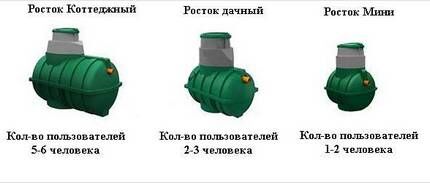
Here is a list of Rostock septic tank models that are in high demand among consumers:
- Mini. The volume of this model is 1000 liters. Within 24 hours, it is capable of purifying approximately 0.3 cubic meters of wastewater. The Mini septic tank is designed for 1-2 users. It weighs 60 kg, dimensions 128x110 cm and depth 170 cm.
- Dachny. With a device volume of 1500 liters, it purifies 0.45 cubic meters of wastewater per day. The “Dachny” septic tank is designed for 2-3 users. It has a weight of 100 kg, dimensions 170x112 cm and depth - 184 cm.
- Country. The model has a volume of 2400 liters and is capable of purifying 0.88 cubic meters of wastewater per day. The Zagorodny septic tank is designed for 4-5 users. It has a weight of 150 kg, dimensions 222x130.5 cm and depth - 199.5 cm.
- Cottage. With a tank volume of 3000 liters, it cleans 1.15 cubic meters of wastewater daily. The Cottage septic tank is designed for 5-6 users. It weighs 190 kg, dimensions 236x144 cm and depth 200 cm.
The inlet and outlet openings in each of the presented models have a diameter of 110 mm. From the top, the inlet hole is located at a distance of 80 cm, and the outlet hole is 85 cm.
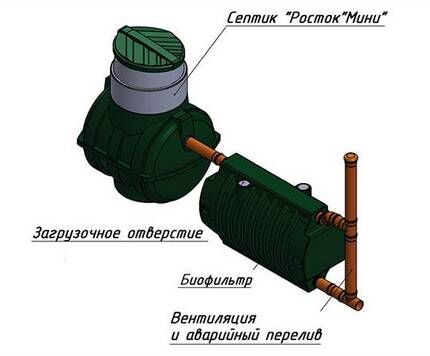
Of course, this list cannot be considered exhaustive. Other models bearing the name “Rostock” are also sold. They can be additionally equipped with biofilters and other systems for post-treatment of sewage water.
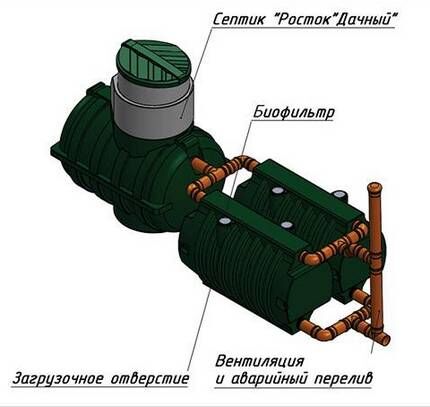
The prices for these septic tanks depend not only on the amount of treatment equipment they are equipped with, but also on the performance of different models.
As an example of the price range, we can cite recent prices for the simplest septic tank - “Mini”. This model was on sale at a price of 25-26 thousand rubles, while the “Cottage” model in the same time period cost 55 thousand rubles.
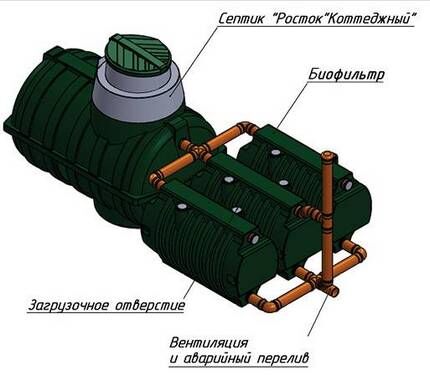
Features and criteria for choosing a septic tank are given here. We recommend that you read this very useful information.
Installation of a treatment plant
One of the advantages of the Rostok cleaning device is that you can install it yourself without spending money on paying for the services of external specialists. With standard steps septic tank installation will familiarize you with the material we recommend.
Installation and connection of a Rostock treatment plant includes a number of standard steps:
Choosing a location for a septic tank
There are regulatory documents according to which a septic tank can be located close to the house, but at a distance of no closer than five meters. This distance is considered optimal for a number of reasons.
The sewer pipe leading to the septic tank should be located at an angle so that the drains move by gravity. A distance that is too long will lead to the need to bury the septic tank too deeply. In addition, the longer the sewer network entering the treatment plant tank, the more likely it is to become clogged.
Regulatory documents, such as SNiP 2.04.03-85 and others, contain some restrictions regarding the location of the septic tank.
It must be located in a place located:
- 5 meters from buildings;
- 50 meters to a water source (well or well);
- 5 meters from the side of the road;
- 3 meters from the trees.
The direction of movement of groundwater is also taken into account: it should be from the water source to the septic tank, and not vice versa. Practitioners believe that with this location of the well, the septic tank can be located 30 meters from the water source. There will be no deterioration in its quality. Fifty meters is a standard, which is not always possible to take into account based on the actual size of the site.
Development of trenches and pits
The drain pipe coming from a country house or cottage should be below the freezing level of the soil.It is believed that for central Russia the depth of the trench should be approximately 1.5 meters.
However, this indicator is individual and depends on the specific area. The proposed pipe slope should be 1:50 or 2 cm/meter. Such parameters must be taken into account when digging a supply trench.
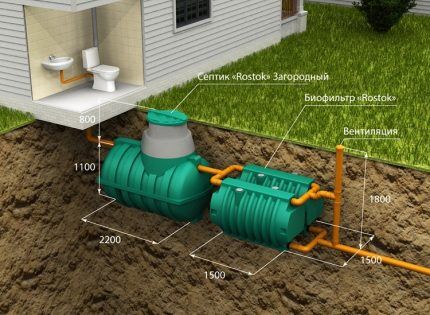
There should be a sand cushion under the sewer pipe.
To install the septic tank itself, you need to dig a pit. The parameters of the base of the pit should be 60 cm greater than the corresponding dimensions of the bottom of the septic tank. It is desirable that the bottom of the pit be strictly horizontal. The permissible deviation is only 10 mm per meter.
You should also dig a trench for the outlet pipe. Its optimal slope is 1:100 or 1 cm per meter.
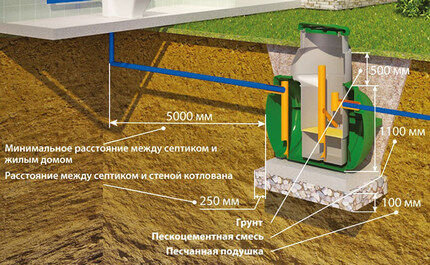
Installation of a treatment plant
Polypropylene products are used as sewer pipes that carry wastewater into a septic tank. Choose products designed for non-pressure external networks. Their diameter should be 110 mm. Individual sections of the pipeline should be connected using couplings with rubber seals.
Similar pipes connect the septic tank and the filtration field. To insulate both pipeline lines, you can use foamed polyethylene or ordinary expanded clay backfill.
The septic tank itself can be installed in different ways. The choice of the optimal option depends on the level at which groundwater occurs under your site.
- With deep groundwater. It is enough to compact the bottom of the pit well, and then lay a sand cushion on the bottom of the pit. Its thickness should be 10-30 cm. A polyethylene tank is installed on this pillow. Try to place it strictly in the center of the pit. The gap between the soil and the container should be approximately 30 cm.
- In case of high location of groundwater. A reinforced concrete slab equipped with eyelets made of concrete-bonding reinforcement is laid on the base of the pit. To prevent the container from “floating”, it is tied to the stove using plastic straps.
If problems arise with the purchase of the slab, you can replace it with four standard curb stones. They will perfectly play the role of anchors. Another way out is to independently concreting the bottom of the pit.
Final stage of work
To ensure that sand surrounds the pipeline on all sides, when backfilling the trench, the pipes are manually covered with sand. And then the excavation can be filled with soil dumped during the formation of the pit.
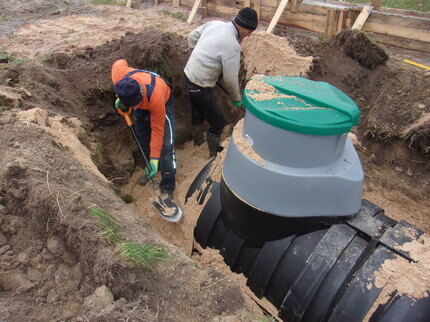
Either clean sand or a mixture of sand and cement is also poured between the walls of the tank and the pit. When preparing a mixture of 80% sand, add 20% cement. Filling the gap should occur layer by layer. Each layer of 20-30 cm is carefully compacted.
Before pouring the next layer of mixture or sand, it is necessary to fill the septic tank with water level with the future layer. On top of all layers, a soil-vegetative layer is placed in the pit and trench.
A few words about additional filtration of wastewater
Typically, after the Rostok treatment device, biological or soil treatment systems are installed.
When the groundwater level is from 1.2 meters and deeper and the sandy non-cohesive type of soil, it is used filter field. This is the name given to a set that includes distribution and irrigation pipelines.
When the groundwater level is 1.5 meters and deeper, a set of Drainage Tunnels is used. Rostok biofilters can be used on any soil and at any groundwater level. For additional cleaning and drainage of wastewater after the septic tank, you can install absorption well.
When installing an additional filter, the finished products are placed on a bed of crushed stone 30 cm thick. The gap between the filter and the soil is filled with layers of crushed stone and sand, introduced alternately.
You can build a filtering, or absorption, well yourself. To do this, install 2-3 reinforced concrete rings. Successfully cope with the function of the absorption well tire drain pit, the device of which we recommend familiarizing yourself with.
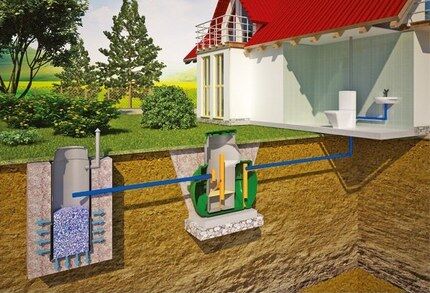
It is necessary to waterproof the resulting body, after which it is filled 100 cm in layers, first with sand, then with gravel or crushed stone. The fraction of each lower layer of backfill should be less than that of the overlying one.
If the bottom ring of the well is buried in sandy loam soil that does not have good filtering qualities, then lateral drainage is arranged. To do this, either initially use a concrete ring with perforation, or drill holes for drainage flow in the walls of the ring after installation in the pit. The diameter of the holes being formed is 10 mm, the spacing is 5 - 10 cm.
Conclusions and useful video on the topic
They say that it is better to see once than to read or hear. Therefore, as a clear demonstration of the operating principle of the Rostock septic tank, we invite you to watch this video:
The following video will introduce you to the process of installing a septic tank. You will see the stage-by-stage installation of the Rostok autonomous sewerage system of the Zagorodny model with the arrangement of the filtration field:
It is not true that the romance of country life must necessarily be accompanied by a rejection of city amenities. On the contrary, summer holidays at the dacha should be as comfortable as possible. Let you have cold and hot water, warmth on a cool day and, of course, an autonomous sewage system that allows you to dispose of wastewater without harm to the environment.
Have you also installed a Rostock brand septic tank at your summer cottage? Or did your neighbors use this option, but you know exactly all the technological details? Share them in the block below, please leave comments, ask questions, post photos on the topic.




I had experience using a Rostock septic tank, and the experience was negative. A little more than a year after installation, a characteristic unpleasant odor began to appear in the place where the septic tank was installed. Plus, the water from the toilet began to drain very slowly. I had to dig it up. As a result, it turned out that the septic tank was deformed and cracked. Either it was installed somehow wrong, or for some other reason, but we installed the next septic tank from another company.
Any septic tank made of plastic is subject to compression by soil. Yes, the manufacturer claims a reliable design and special stiffening ribs, but plastic is plastic.
I can attach a photo of the septic tank, which we had to reinstall after self-installation by one of the summer residents. You may notice that the frame is seriously deformed laterally from being compressed by the soil. It’s good that there were no cracks and the structure was leveled.
It is necessary to bury the plastic septic tank to the depth recommended by the manufacturer.And it is better to fill the pit around it with a sand-cement mixture intended specifically for this work. Having hardened, it will play the role of a “shell”, protecting it from ground pressure, and at the same time from flood water.
To protect against cold weather, it is better to use board insulation with minimal moisture absorption, for example, penoplex. In this case, it will be possible to avoid compression and deformation of the structure.
We spend most of our time at the dacha. Naturally, the amenities were organized in a civilized manner, although the general infrastructure in the village under construction is not at all developed. About the Rostok septic tank, I can say that I am satisfied with it, it is very functional and easy to install. For our option, you can’t think of anything better yet: we’ve already seen the quality of cleaning.
What I like most about septic tanks from the Ecoprom company is that they have a wide range of models, you can easily choose them for a country house or large country house in terms of volume and performance. Due to this, it is possible to optimize sewerage costs
They advised me to take a mini model to the dacha, brand Rostok from EcoProm. Before this, ours seemed to be designed for 1-2 people, but it clearly couldn’t handle it and eventually broke down. And this one worked the whole season without problems.
In principle, a good unit. I work at a construction site, we get dry toilets from Ecoprom - they are good. Well, a dry closet is not an option for me, so I decided to look into a septic tank. Reliable, works flawlessly. I can’t say anything negative about him yet
I am professionally involved in the installation of septic tanks, sewer systems and other things.They constantly ask for Rostock septic tank products from Ecoprom, because people like the quality. I myself recommend this manufacturer to those who have doubts. Durability and low price are the main advantages.
Rostok is a brand from Ecoprom, I took such a septic tank to my dacha at the beginning of the season. Just the model called Dachny. A successful septic tank, sealed with several degrees of purification. After the septic tank, I also installed a biofilter - it works great, while the dimensions are quite compact
Ecoprom specialists installed a septic tank for us, I didn’t even try to do it myself, now you’ll save money, because there will be problems. The sprout has been standing for two years now, neither winter, nor soil pressure, nor washing waters have damaged it.
Served for two years the lid does not fit tightly the chains flew off the hinge for opening the lid rusts in March gift: the peat in the biofilter stopped working as a result 30 thousand rubles and filled with new peat expanded clay now September the peat stops working the water costs I think what to do so think about buying biofilters for the sprout